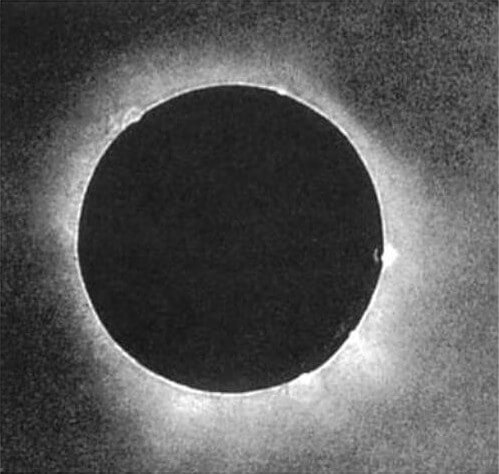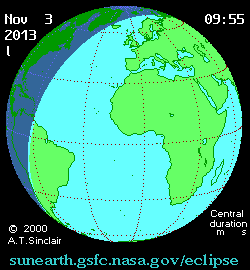The eclipse will begin as an annular eclipse over the Atlantic Ocean not far from the coast of Florida, and will become a total eclipse south of Liberia * In several countries in East Africa, viewers will be able to see the sun setting

Tomorrow, 3/11/13, the last eclipse for 2013 will occur, it will be the fifth eclipse this year after another solar eclipse and three lunar eclipses, however the previous solar eclipse was partial, and now this one also barely shows hints of a total eclipse.
Tomorrow's solar eclipse will be a hybrid eclipse - it will begin as an annular eclipse for the first 15 seconds of its orbit before the entire moon's shadow approaches the Earth's surface and covers the entire solar disk for the rest of its orbit. The reason for this behavior (and the short duration of the eclipse even in places where it is full) is that the sun is relatively close to the earth (the greatest approach to the sun - the perihelion in the earth's orbit occurs on January 3 or 4), and the moon is not quite at its closest point, so it is difficult To cover the whole face of the sun.
How rare are hybrid solar eclipses? Of the 11,898 solar eclipses recorded in the 5,000 years between 3000 BC and 1999 in Fred Aspenk's "Five Millennials of Solar Eclipses" catalog, only 569 or 4.8% were hybrid eclipses.
The eclipse will begin as usual at sunrise, in the Atlantic Ocean about a thousand kilometers east of Florida, and a partial eclipse will be visible on the east coast of the USA and the north coast of South America. Almost all countries in Africa, southern Europe and some of Asia will be able to see parts of the eclipse. The full part of the eclipse will begin when the sun is west of the coast of Liberia, and it will enter the continent over the Wonga Wongo Game Reserve in Gabon. At this point, the total length of the eclipse will have shrunk to one minute and seven seconds. The moon's shadow will cross Africa and allow viewing of a short but beautiful eclipse at sunset over Uganda, Ethiopia, Kenya and Somalia.

This eclipse is part of the Saros 143 series and is number 23 out of the 72 eclipses in this cycle. The first eclipse in this series occurred on March 7, 1617 and the last will take place on April 23, 2897. The previous eclipse in the series crossed Southeast Asia on October 24, 1995.
The first detailed photograph of a solar eclipse was the Saros 143 eclipse on July 28, 1851. The next eclipse in the series on August 7, 1869 saved the life of astronomer and algae discoverer George Davidson who was exploring the Alaskan countryside. The next eclipse in the series, on August 19, 1887, was observed and recorded by Dmitri Mendeleev, known as the discoverer of the periodic table.
And of course, as in any eclipse, certainly in a partial eclipse, the astronomers call for caution and not to observe the sun directly, but through special filters and preferably through dedicated eclipse glasses (welder's glass #14). Astronomers Without Borders Association (Astronomers Without Borders) has been working in recent weeks to distribute eclipse glasses to schools in Africa.
see also: A total solar eclipse will occur this Sunday in Africa; A partial eclipse will be seen in Israel
To the news in Universe Today, on which this article is based

5 תגובות
Well:
In 1869, astronomer and explorer George Davidson made a scientific trip to the Chilkat Valley of Alaska. He told the Chilkat Indians that he was especially anxious to observe a total eclipse of the sun that was predicted to occur the following day, August 7. This prediction was considered to have saved them from an attack
http://en.wikipedia.org/wiki/Solar_eclipse_of_August_7,_1869
And here:
http://www.history.com/this-day-in-history/astronomer-impresses-indians-with-eclipse
To my father Belizowski: You can't write the sentence "The next eclipse in the series on August 7, 1869 saved the life of the astronomer and algae discoverer George Davidson who was exploring the vastness of Alaska" and leave us with the mystery of how a solar eclipse saved his life (I remember an imaginary literary case of saving a life thanks to a solar eclipse in Mark Twain's book "A Yankee in King Arthur's Court" but, as mentioned, imaginary as well as fictional).
Tomer, according to the map, the peak in Israel will be around 4 pm, and will only reach 25% coverage of the sun
What time will it be possible to see it from Israel?